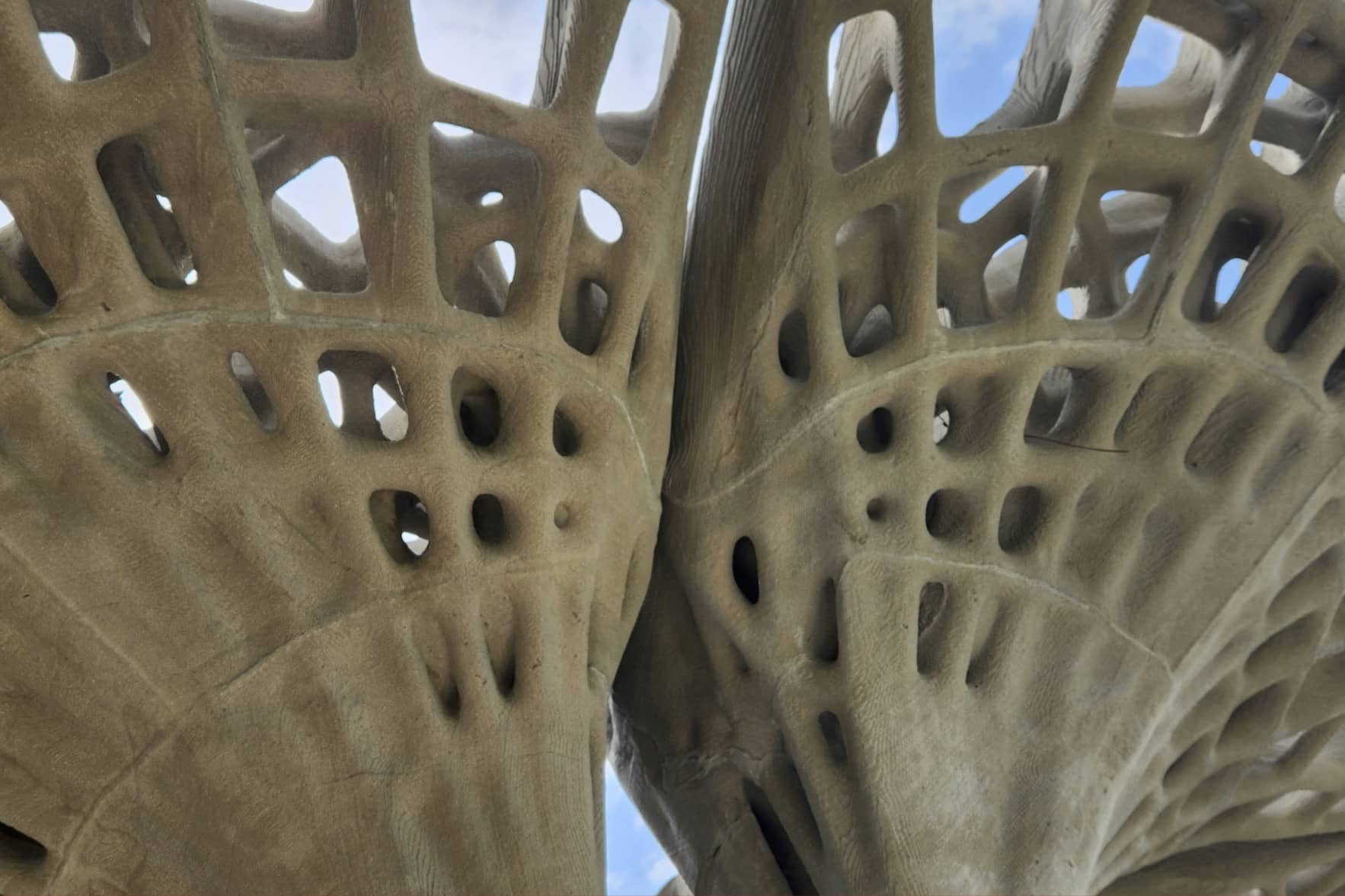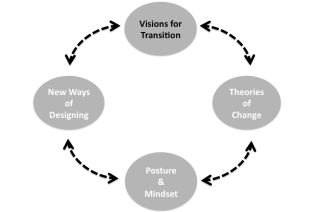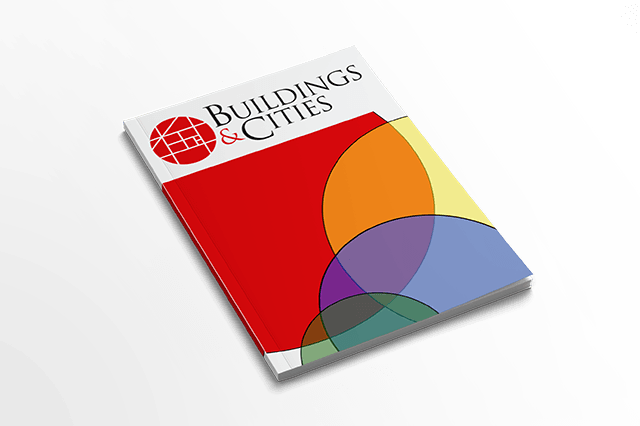
www.buildingsandcities.org/insights/commentaries/sixth-industrial-revolution.html
The Sixth Industrial Revolution Should be Ecological

Why the next industrial revolution needs to be based on nature and not "technology"
Over the past 50 years the world has seen countless summits and agreements to reduce carbon emissions and prevent ecological overshoot. We have seen widespread adoption of the SDGs, a rapid shift to renewable energy, and numerous urban planning strategies to create biodiversity corridors, rewild rivers, and enable public and non-motorised transport options. However, appearances are deceiving. Chrisna du Plessis (University of Pretoria) considers the challenge of how to foster an ecological civilization in a world obsessed with technological innovation.
The United Nations (2024) warned that "that only 17% of the SDG [Sustainable Development Goals] targets are on track, nearly half are showing minimal or moderate progress, and progress on over one third has stalled or even regressed". The past 50 years saw a 73% decrease in the size of monitored wildlife populations (WWF 2024) and the world has already exceeded the safe operating space for six of the nine planetary boundaries (Richardson et al. 2023). Global greenhouse gas (GHG) emissions continue to set new records year-on-year, with the 2023 record of 57.1 GtCO2e a 1.3% increase from 2022 levels (UNEP 2024). The world's top climate scientists issued a harrowing report in 2024, warning that the world is on the brink of an "irreversible climate disaster" (Ripple et al. 2024). In an unprecedented move, they illustrated this article with not just graphs, but a series of photographs to illustrate the human suffering already unfolding as a result of climate change.
To understand why the needle is not shifting in the right direction, we need to look at other patterns in industry and the global economy, and specifically the explosive growth of the fourth, and more recently, fifth industrial revolutions and the social innovations they engender. Industrial revolutions are prompted by revolutionary technologies that change what is produced and the way things are produced, and this, in turn, changes ways of working and living (Groumpos 2021). The Fourth Industrial Revolution (4IR) (Schwab 2016) introduced new technologies that are fusing the physical, digital and biological worlds to fundamentally change the way humans experience and interact with the world. These technologies range from robotics and artificial intelligence that allow marvels such as autonomous vehicles and additive manufacturing, to new haptic human-machine interfaces and virtual reality systems and the use of machine learning and large language models to drive innovation in everything from financial, health and communication systems to the transition to renewable energy. However, there are concerns that the Fourth Industrial Revolution is not aligned with the goals of sustainability or the psychological needs of humans, and there have been several attempts to define the next step; a Fifth Industrial Revolution (5IR) (European Commission 2021). While it is difficult to draw clear boundaries between 4IR and 5IR, as the one builds so closely on the other, there is growing consensus that 5IR technologies should be human-centred and focus on human-machine interactions for greater human, and hopefully, planetary well-being through innovations such as collaborative robotics, the merging of cyberspace and physical space through virtual reality, and the integration of digital technology and biotechnology (Noble et al. 2022).
Exciting as this may be, the unfortunate fact is that these 4IR and 5IR technologies and their basis in a largely extractive manufacturing and economic paradigm is supercharging the very social and environmental ills the world hoped to overcome through the SDGs and the various biodiversity and climate treaties. While traditionally energy-intensive industries such as transportation and the built environment have taken great strides in reducing energy demand, this reduction has become meaningless as the digital world, and the lifestyles it encourages, gobbles up energy and resources thus cancelling out many of the gains made in other sectors. Data centres are responsible for 2% of total GHG emissions, with predictions that by 2040, digital data storage will contribute up to 14% of the world's carbon emissions (Thangam et al. 2024). This excludes energy consumption and emissions as part of the lifecycle of IT hardware manufacturing and software development and end-user energy consumption. It also excludes other associated ecological impacts such as water consumption and the mining of rare earth minerals. The truly terrifying part is that a large share of this impact is driven by the attention economy (Davenport & Beck 2001), especially social media and its influencer culture built on conspicuous overconsumption
It is not possible to put the genie back in the bottle, so our only option is to push through to a Sixth Industrial Revolution (6IR) that offers an alternative pathway that may just allow Homo sapiens to survive its own folly. Right now, we are at a crossroads. We can continue our cyberpunk journey towards transhumanism, pursuing the development of technologies that combine information technology, biotechnology, nanotechnology and cognitive science such as molecular engineering and natural organic artificial intelligence systems (Chourasia et al. 2022; Ruiz Estrada 2024). However, this is not a path that will help us to navigate and survive ecological overshoot and the coming climate calamity, let alone regenerate the dying social-ecological systems on which we depend.
Instead, the next industrial revolution should be based on the sciences and goals of life. This ecological 6IR flips the script on what defines an industrial revolution by prompting a shift towards an industrial model based on how nature works. It shifts the technology focus away from digital innovation to bio-based and biotechnical innovation and from extractive to regenerative modes of production. The challenge for future research then lies in defining and developing three core aspects of the 6IR:
- The way things are produced:
Benyus (2002) proposed that in a biomimetic world we would manufacture, farm and develop the way animals, plants and ecosystems do, with technology and manufacturing processes that are life-friendly (i.e. at low temperature and low pressure conditions) and abide by the laws of nature, such as running on sunlight, circularity, and symbiotic cooperation. Manufacturing can include a spectrum of practices from growing biodegradable and organic self-healing materials for additive manufacturing to bio-hybrid construction and swarm robotics. The goal is to create construction processes and structures that mimic natural systems and enhance ecological harmony. -
What is produced:
The 6IR should produce technologies and materials that work in partnership with nature, using organic materials and ecosystemic intelligence. Examples include organic electronics, algae batteries and 3rd generation bio-based materials such as biopolymers using swarm robotics to construct structures. At a larger scale it produces living buildings constructed from biobased materials, and even living biomass, to create adaptive, biophilic and more-than-human living environments using approaches such as interspecies design, design for biodiversity and regenerative design. -
Ways of living and working:
The biggest challenge to creating built environments that would support an ecological way of living is not technological, but to find ways for buildings and cities that create connections with body, nature and community, both physically and psychologically, to replace the attention economy's hold on our collective psyche and for humans learning to live consciously in the world, drawing on both ancestral wisdom and neuroscience.
The threads of this new, nature-based and nature-embracing industrial revolution are already being spun in many different places and only need to be woven together into the fabric for a radically different, live-affirming future in which all our descendants can thrive, not just survive.
References
Benyus, J.M. (2002). Biomimicry: Innovation Inspired by Nature. New York: HarperCollins Perennial (3rd ed.).
Chourasia, S., Tyagi, A., Pandey, S.M., Walia, R.S. & Murtaza, Q. (2022). Sustainability of industry 6.0 in global perspective: benefits and challenges. MAPAN (Journal of Metrology Society of India) 37, 443-452. https://doi.org/10.1007/s12647-022-00541-w
Davenport, T. & Beck, J. (2001). The Attention Economy: Understanding the New Currency of Business. Cambridge: MA: Harvard Business School Press.
European Commission: Directorate-General for Research and Innovation, Renda, A., Schwaag Serger, S., Tataj, D., Morlet, A. et al. (2021). Industry 5.0, a transformative vision for Europe: Governing systemic transformations towards a sustainable industry. Publications Office of the European Union. https://data.europa.eu/doi/10.2777/17322
Groumpos, P.P. (2021). A critical historical and scientific overview of all industrial revolutions, IFAC-Papers Online, 54(13), pp 464-471. https://doi.org/10.1016/j.ifacol.2021.10.492
Noble, S.M., Mende, M., Grewal, D & Parasuraman, A. (2022). The fifth industrial revolution: how harmonious human-machine collaboration is triggering a retail and service [r]evolution, Journal of Retailing, 98 (2), 199-208. https://doi.org/10.1016/j.jretai.2022.04.003
Ripple, W.J., Wolf, C., Gregg, J.W., Rockström, J., Mann, M.E., Oreskes, N., Lenton,T .M., Rahmstorf, S., Newsome, T.M., Chi Xu, Svenning, J., Cardoso Pereira, C., Law, B.E. & Crowther, T.W. (2024). The 2024 state of the climate report: Perilous times on planet Earth. BioScience, biae087, https://doi.org/10.1093/biosci/biae087
Richardson, K., Steffen, W., Lucht, W., Bendsten, J., Cornell, S.E., Donges, J.F., Drüke, M., Fetzer, I., Govindasamay, B. & Röckstrom, J. (2023). Earth beyond six of nine planetary boundaries. Science Advances.9(37). https://doi.org/10.1126/sciadv.adh2458
Ruiz Estrada, M.A. (2024). The seventh industrial revolution (IR 7.0). SSRN: https://ssrn.com/abstract=4720983 or http://dx.doi.org/10.2139/ssrn.4720983
Schwab, K. (2016). The Fourth Industrial Revolution. New York: Crown Publishing Group
Thangam, D., Muniraju, H., Ramesh, R., Narasimhaiah, R., Muddasir Ahamed Khan, N., Booshan, S., Booshan, B., Manickam, T. & Sankar Ganesh, R. (2024). Impact of data centers on power consumption, climate change, and sustainability. Dinesh Kumar, K., et al (eds.) Computational Intelligence for Green Cloud Computing and Digital Waste Management. New York: IGI Global Scientific Publishing. Pp. 60-83. https://doi.org/10.4018/979-8-3693-1552-1.ch004
United Nations. (2024). The Sustainable Development Goals Report. New York: United Nations Publications.
UNEP. (2024). Emissions Gap Report 2024: No more hot air ... please! Nairobi: United National Environment Progreamme. https://wedocs.unep.org/20.500.11822/46404
WWF. (2024). Living Planet Report 2024 - A System in Peril. Gland, Switzerland: WWF
Latest Peer-Reviewed Journal Content
Designing for pro-environmental behaviour change: the aspiration–reality gap
J Simpson & J Uttley
Lifetimes of demolished buildings in US and European cities
J Berglund-Brown, I Dobie, J Hewitt, C De Wolf & J Ochsendorf
Expanding the framework of urban living labs using grassroots methods
T Ahmed, I Delsante & L Migliavacca
Youth engagement in urban living labs: tools, methods and pedagogies
N Charalambous, C Panayi, C Mady, T Augustinčić & D Berc
Co-creating urban transformation: a stakeholder analysis for Germany’s heat transition
P Heger, C Bieber, M Hendawy & A Shooshtari
Placemaking living lab: creating resilient social and spatial infrastructures
M Dodd, N Madabhushi & R Lees
Church pipe organs: historical tuning records as indoor environmental evidence
B Bingley, A Knight & Y Xing
A framework for 1.5°C-aligned GHG budgets in architecture
G Betti, I Spaar, D Bachmann, A Jerosch-Herold, E Kühner, R Yang, K Avhad & S Sinning
Net zero retrofit of the building stock [editorial]
D Godoy-Shimizu & P Steadman
Co-learning in living labs: nurturing civic agency and resilience
A Belfield
The importance of multi-roles and code-switching in living labs
H Noller & A Tarik
Researchers’ shifting roles in living labs for knowledge co-production
C-C Dobre & G Faldi
Increasing civic resilience in urban living labs: city authorities’ roles
E Alatalo, M Laine & M Kyrönviita
Co-curation as civic practice in community engagement
Z Li, M Sunikka-Blank, R Purohit & F Samuel
Preserving buildings: emission reductions from circular economy strategies in Austria
N Alaux, V Kulmer, J Vogel & A Passer
Urban living labs: relationality between institutions and local circularity
P Palo, M Adelfio, J Lundin & E Brandão
Living labs: epistemic modelling, temporariness and land value
J Clossick, T Khonsari & U Steven
Co-creating interventions to prevent mosquito-borne disease transmission in hospitals
O Sloan Wood, E Lupenza, D M Agnello, J B Knudsen, M Msellem, K L Schiøler & F Saleh
Circularity at the neighbourhood scale: co-creative living lab lessons
J Honsa, A Versele, T Van de Kerckhove & C Piccardo
Positive energy districts and energy communities: how living labs create value
E Malakhatka, O Shafqat, A Sandoff & L Thuvander
Built environment governance and professionalism: the end of laissez-faire (again)
S Foxell
Co-creating justice in housing energy transitions through energy living labs
D Ricci, C Leiwakabessy, S van Wieringen, P de Koning & T Konstantinou
HVAC characterisation of existing Canadian buildings for decarbonisation retrofit identification
J Adebisi & J J McArthur
Simulation and the building performance gap [editorial]
M Donn
Developing criteria for effective building-sector commitments in nationally determined contributions
P Graham, K McFarlane & M Taheri
Join Our Community

The most important part of any journal is our people – readers, authors, reviewers, editorial board members and editors. You are cordially invited to join our community by joining our mailing list. We send out occasional emails about the journal – calls for papers, special issues, events and more.
We will not share your email with third parties. Read more



Latest Commentaries
COP30 Report
Matti Kuittinen (Aalto University) reflects on his experience of attending the 2025 UN Conference of the Parties in Belém, Brazil. The roadmaps and commitments failed to deliver the objectives of the 2025 Paris Agreement. However, 2 countries - Japan and Senegal - announced they are creating roadmaps to decarbonise their buildings. An international group of government ministers put housing on the agenda - specifying the need for reduced carbon and energy use along with affordability, quality and climate resilience.
Building-Related Research: New Context, New Challenges
Raymond J. Cole (University of British Columbia) reflects on the key challenges raised in the 34 commissioned essays for Buildings & Cities 5th anniversary. Not only are key research issues identified, but the consequences of changing contexts for conducting research and tailoring its influence on society are highlighted as key areas of action.